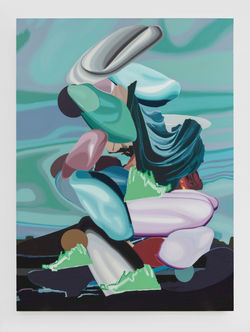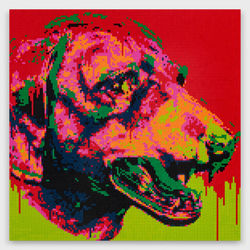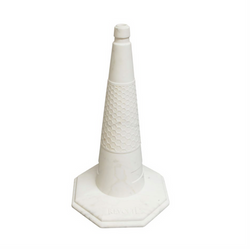Tang Contemporary Art is proud to announce the opening of “A dream within a dream,” a group exhibition curated by Michela Sena and featuring the works by Ai Weiwei, Ayka Go, Dinh Q Le, Gerald Davis, Raffy Napay, Wang Jian Wei, Yue Minjun, Yunizar at Tang Contemporary Art in its Bangkok space. The exhibition is running from March 31th through May 3rd, 2022. The exhibition features works by Chinese and international contemporary artists from all around the world, who use a variety of techniques and styles but come together to form an unified identity in the show.
"A dream within a dream", this is how Edgar Allan Poe titled his poem in 1849; not only is this poem one of his most famous, it’s also one of the darkest. It expresses doubt and uncertainty about the nature of reality, questioning whether life itself is just an illusion: "a dream within a dream."
In the same way, the artists on show are all confronted with the concept of reality. Confrontation can be disarming, inevitably leading to introspection. This is the case with Wang Jianwei. His artworks subvert the concepts of time and space to give new life to an indecipherable reality. Returning us an individual and sublime perception of his own artistic world. So magnificent from an aesthetic point of view and equally profound on a conceptual level.
Similarly introspective is Yue Minjun's reaction who, with his obsessive repetition of “self”, is in search of a lost identity. His laughter, the hallmark of his work, is Yue Minjun’ representation of a state of helplessness, detachment from contemporaneity. The same laughter gave birth to artworks that are milestones in the history of contemporary Chinese art. The works on show in our exhibition belong to his mature season. The color palette becomes more vivid, the flowers and shapes suggest a dreamy atmosphere allowing the aesthetic factor to prevail, giving life to absolute masterpieces
Unique is Ai Weiwei's approach to reality. A reality he no longer recognizes and where he feels lost, using his own words, while referring to refugees : “I am a refugee, every bit... Those people are me. That’s my identity.” Struggling to feel at ease in a society that changed much faster than the human pace, he finds himself an orphan of his own context.
His reaction meets his characteristic “self-centered” practice: in his works art and identity coincide. His vision of reality molds his identity, leading him to incontrovertible active practices. In Ai Weiwei’ art the collision with reality generates active reactions towards the outside, without boundaries between the reality and what he feels, what he sees and what he returns to us.
Extroverted reaction to reality is also Dinh Q Lê’ practice. Born in 1968 in Vietnam, Lê’s work and art practice revolve around the themes of identity, history, and memory, which span from his well-known woven photographs to different media. He questions how visual culture may influence the perception of a national identity. Lê was a refugee relocating to the United States. In California where he lived and studied, was sparked by the prevailing perceptions of the Vietnam War and its lingering consequences on the Vietnamese community.
Coming directly from the natural world that surrounds him, the elements depicted in Yunizar’ canvas, become characters of his artistic imagery. Conceived from the holistic concept of “rasa” (the act of perceiving the whole at once, involving simultaneously feelings, emotions, sensations, perceptions and judgments), his works depict visions of a lost world, so natural and archetypal as to become mythological. Unaffected by any trend coming from contemporary society, Yunizar silently witnesses the transformation of Indonesian traditional culture, gradually eroded under the pressure of modernity, yet present contingencies can’t override his own dimension.
Davis's works are among the best examples of the recent return to figurative painting.
Through the element of beauty, he gradually brings the viewer to dig into an intimate dimension, made of dreams, fantasies, memories. The external reality is no more important than the intimate dimension, where his paintings originate.
So are Raffy Napay’ and Ayka Go’ works. Napay uses cotton treads to realize his famous textiles and the reason why he chose this material is probably to be found in his childhood. Growing up with a seamstress mother, he was exposed from a very early age to textiles and fabric. The memory of a lost childhood is resonating through colorful threads in his works.
Ayka Go’ world is the construction of a metaphysical reality: in a suspended atmosphere, random details of everyday life are enlightened by the lenses of her unconscious and suddenly reality appears as we had never seen it.
Download Press Release
 Wang Jian WeiDense No.9 Oil on canvas 74.5 x 250 cm 2020 |  Wang Jian WeiAlways being, but not the whole No.18 Oil on canvas 250 x 187cm 2021 |  Wang Jian WeiAlways being, but not the whole No.33 Mixed media 120 x 90 x 118cm 2022 |
|---|---|---|
 Ayka GoTraces: Deconstructed Butterfly Pattern Oil on Canvas Diameter 120 cm 2022 |  Ayka GoUnfolded Paper Boat Oil on Canvas 91 x 121 cm 2022 |  Gerald DavisVase with Boy Recieving Communion Oil on Canvas 300 x 200 cm 2021 |
 Gerald DavisPrimavera Porcelain with Lemons Oil on Canvas 203 x 139 cm 2021 |  Gerald DavisTurquoise Ceramic with Lemons Oil on Canvas 198 x 139 cm 2022 |  Ai WeiweiZodiac Dog LEGO bricks 115 x 115 cm 2018 |
 Ai WeiweiZodiac Chicken LEGO bricks 115 x 115 cm 2018 |  Ai WeiweiRevolt Marble Sculpture Installation 48 x 48 x 80 cm 2019 |  Yue MinjunPaste No.2 Oil on canvas 170 x 140cm 2019 |
 Yue MinjunUntitled Oil on Canvas 250 x 250 cm 2015 |  Yue MinjunUntitled Oil on Canvas 100 x 80 cm 2012 |  YunizarUntitled Acrylic on canvas 200 x 240 cm 2022 |
 Raffy NapayUntitled Embroidery 175 x 175 cm 2015 |  Dinh Q LeUntitled Photo-weaving technique 150 x 220 cm |
Curator

Michela Sena
b. 1976
Michela Sena is a Rome-Bangkok based curator and art critic. Her research relates partly to the potential of global language and the relationship and dialogue between contemporary artists coming from different territories. After she graduated in museology and art history at Roma Tre University and got a Chinese language degree at SISU Shanghai Foreign Studies University, she was Director of Primo Marella Gallery Beijing and Director of Tang Contemporary Art Bangkok. She curated a wide number of shows proposing a punctual snapshot of contemporary art research, developing in recent years a focus on Chinese and South East Asian art.



